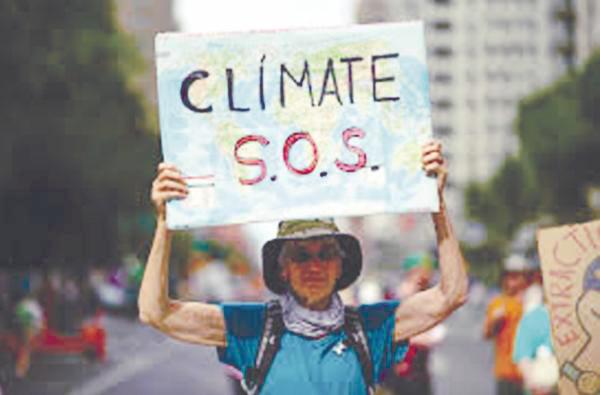ONE of the most poignant stories to emerge from West Asia is the tale of humanity’s advent and fall contained in an old Hebrew scripture called the Torah. Known as the Adam and Eve story, it has captured public imagination since it circulated throughout the world.
Thinkers have always sensed that the story is an account of the fall of humanity into relationship conflicts in all spheres of life. Conflicts remain never-ending and are exacerbated by the rising threat of climate change arising from conflict with nature.
It is a top-of-mind concern as the phenomenon of global climate change has never been previously encountered, and no force at our disposal seems able to stop it from accelerating. A growing number of scientists fear that it will lead to a cataclysmic crisis for humanity.
Does the Adam and Eve story, which endeavours to trace the path that humanity took from harmony to conflict, address the root malaise that has led to climate change? Yes, it does.
Our science-based elucidation of the story’s intricate meaning resonates with the thinking of primitive hunter-gatherer folks who have long pinpointed this malaise to us.
Let us unravel the Adam and Eve story from a science perspective. To begin with, the story which occurs very early in the book of Genesis is not a literal account of some tragic incident. The giveaway is in the character of the villain: it is a serpent that is able to engage the woman in a sophisticated conversation. No snake can talk, let alone hold a philosophical discussion.
The story is also not a piece of history-telling. There are many giveaways here, from beginning to end. In the account, Eve is made from one of Adam’s ribs. But we know that biologically in most, if not all, species it is more plausible that the male emerged from the female.
The background motif is that at the time the story was composed, West Asian societies were heavily patriarchial and women were assigned a position subordinate to men in everything.
She was also held to be of inferior intelligence, and hence the serpent approaches her knowing that it can deceive her with its crafty talk. The story writer avoids upsetting firmly embedded sociocultural beliefs.
The story mentions livestock in the Garden of Eden where Adam and Eve dwell, and at the end, they beget two sons. One of them becomes a planter and the other a herder. But we know from science that there was a long gap of 300,000 years from the birth of humanity to the development of agriculture. The Adam and Eve story obviously was not intended to be a chronological account.
What kind of story is it then? It is a stunning allegorical drama that uses powerful metaphors and the ambience of ancient Hebrew society as a colourful backdrop scenery.
The essential message is conveyed by the actions of the dramatis personae with regard to the centrepiece of the drama – da’at vav tov wa ra – popularly translated as knowledge of good and evil.
But translating the Hebrew word ra as “evil” throws the meaning offkey. Hebrew linguists know that the phrase da’at vav tov wa ra broadly means the “experiential knowing of serendipity and calamity” or good fortune and misfortune.
This broader meaning is made clear in another Hebrew sacred book called Isaiah. In verse 45:7 God says: “I bring prosperity and create disaster” (NIV Interlinear Hebrew-English Old Testament). The Hebrew word translated as “disaster” is ra. This verse is rendered in the Orthodox Jewish Bible as: “I make shalom, and create ra”. Shalom means peace. If ra means evil, we have God saying, “I make peace and create evil”.
The story setting suggests that da’at vav tov wa ra implies a mental bifurcation or cutting human experiences in two into combative halves. With mental bifurcation, ra is experienced as evil and becomes opposed to tov.
Mental bifurcation causes us to lose the sense of wholeness and the sense that all is one. As quantum scientists tell us: the universe is not fundamentally made of separate parts at all but is instead a single, indivisible quantum field. And as the first chapter of Genesis records: “God saw all that he had made, and it was very good” (verse 31).
How did evil emerge? Ra becomes evil when there is “a breach of harmony” and “a breaking up of what is good” (Synonyms of the Old Testament by Robert Baker Girdlestone). It is our mental bifurcation that creates evil by dividing relationships into the combative spheres of “I” versus “you” and “we” versus “them”. Instead of humanity in nature, life becomes humanity versus nature.
You can sense this meaning from the action details. God tells Adam and Eve that they “must not eat from the tree of the knowledge of tov wa ra”.
Some early thinkers believed that the forbidden fruit meant sexual intercourse because Adam and Eve realised they were naked after the fruit was consumed. But this interpretation contradicts the text which says: “The man and his wife were both naked, and they felt no shame” (Genesis 2:25).
When Adam and Eve ate the fruit – when their minds indulged in bifurcation – from that moment they fell into a state of disharmony and brokenness characterised by alienation. Their first experience of alienation was the fallout with nature.
“Then the eyes of both of them were opened, and they realised they were naked; so they sewed fig leaves together and made coverings for themselves” (Genesis 3:7). To be naked is the condition of all lifeforms in nature from the amoeba to the ape. Being naked is a figure of speech for living in nature. After the fallout, humanity adopted lifestyles that covered up the way of nature as depicted by the word “coverings” used as a metaphor.
The fallout with nature spins off negative consequences, starting with a breaking off from God. Genesis describes God as “walking in the garden”, figuratively meaning that God is in nature, which is also the home of humanity. But the couple “hid from the Lord God”. In falling out with nature, humanity alienates itself from God.
When God questions Adam, he immediately casts the blame on Eve. That signifies the next breach – the put-down of women resulting in male oppression of females ever since.
Eating the forbidden fruit – mental bifurcation – is a fundamental break that throws humanity out of nature. “So the Lord God banished him from the Garden of Eden” (Genesis 3:23).
The story climaxes with the birth of two sons, elder Cain and the younger Abel. Cain becomes a planter and Abel takes to herding. This metaphorical pair is based on historical facts, as crop planting was first invented 12,000 years ago. Livestock rearing was invented 2,000 years later.
In West Asian societies, herders gained ascendancy over planters and rivalry between them led to violent conflicts. The elder Cain murders Abel. It is historically true that competition over land use and water resources often pits them against each other. Ancient Hebrew society favoured herders as it prized livestock meat and milk.
“Cain brought some of the fruits of the soil as an offering to the Lord. But Abel brought fat portions from some of the firstborn of his flock. The Lord looked with favour on Abel and his offering, but on Cain and his offering he did not look with favour” (Genesis 4:3-5).
In Africa, we see a reverse situation. Herders with their massive cattle herds encroach on government and private lands destroying crops and grasslands, fuelling armed conflicts in the Central African Republic, Chad, Nigeria, Mali, Kenya, Somalia and Sudan. Hence, many African governments favour planters. As herders and planters often belong to different ethnicities and religions, the animosity between them has taken on ethno-religious overtones.
Archaeological evidence suggests that our fallout with nature began when some hunter-gatherer tribes grew much larger and more structurally complex before the invention of agriculture (crop planting and livestock herding).
Unlike agricultural and later urbanised societies, the simple hunter-gatherer tribes surviving to this day continue living in harmony with nature, exhibiting respect for God in nature, gender equality, social cooperation and a disdain for conflict.
In the next article, we shall examine in detail the gruelling journey that humanity has taken from Adam and Eve to climate change – a journey that has brought us to the cliff edge of doom.
Can we steer away from the cliff in time? We shall explain how the “us vs them” and “humanity vs nature” mental bifurcation leads to economic discord, ethnic conflicts, religious strife, national rivalry and now climate change.
The writer champions interfaith harmony. Comments: letters@thesundaily.com










